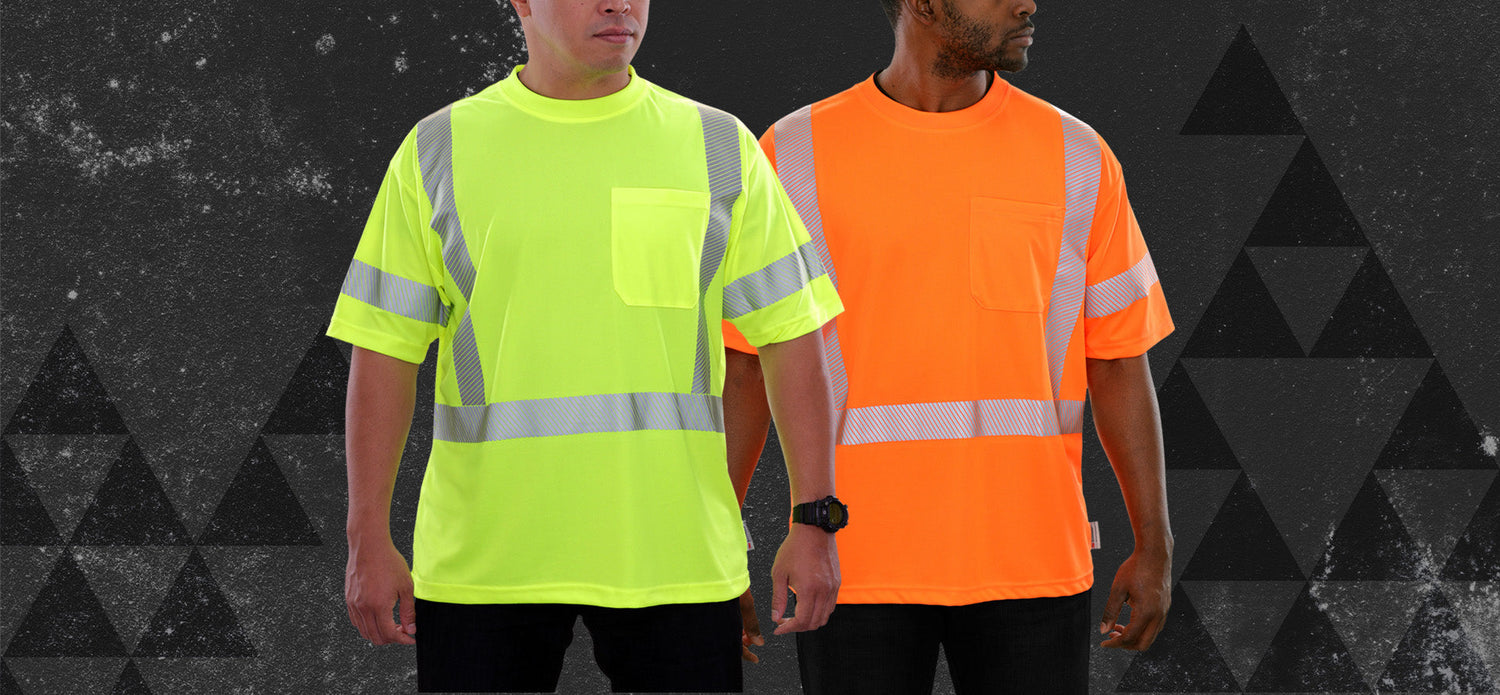In the world of safety, a common question is orange vs yellow high vis apparel; what is the difference, and which color do I choose? High-visibility (hi-vis) apparel is specialized clothing designed to make the wearer easily seen, especially in low-light conditions or hazardous environments. Typically featuring bright colors like neon lime/yellow and orange, these garments often incorporate reflective materials to enhance visibility. Hi-vis apparel is crucial for the safety of workers in industries such as construction, road work, and emergency services, helping to prevent accidents by ensuring they are noticeable to others, including vehicle operators and heavy machinery operators.
Orange vs. Yellow High Visibility Apparel: Key Differences
Orange vs yellow high vis apparel: what are the key differences? Hi-vis orange is a vibrant shade used for safety apparel, providing excellent contrast against most backgrounds. Known as "blaze" or "safety" orange, it ensures workers remain visible in hazardous conditions. Hi-vis yellow safety shirts are a bright, fluorescent shade often referred to as "safety yellow." This color stands out against most backgrounds, making it ideal for safety apparel. Some hi-vis yellow safety garments also incorporate lime shades, leading them to be known as hi-vis "lime/yellow."
Color Composition and Visibility
Orange high-visibility safety shirts typically feature a bright, fluorescent orange color with reflective stripes, offering excellent visibility in natural environments like forests and rural areas where it contrasts sharply with greens and browns. On the other hand, lime/yellow high-visibility apparel features a bright, neon yellow or lime color with reflective materials, making it highly effective in urban settings, low light, and foggy conditions due to its eye-catching brightness.
Industry Standards and Historical Background
Both orange and yellow high-visibility clothing comply with ANSI/ISEA standards. Orange high-visibility apparel has a long history of use, particularly in contexts where safety and visibility are paramount. In the 1960s, the British railway industry was among the first to adopt orange high-visibility clothing for its workers to ensure they were easily seen against natural backgrounds, thus preventing accidents. Since then, orange has become a standard color where high visibility against green grass, foliage, and brown backgrounds is crucial.
Yellow high-visibility apparel has also been widely used, particularly for its effectiveness in diverse lighting conditions. Its use became prominent in the mid-20th century, primarily for urban and low-light environments. The bright, neon yellow color effectively makes workers visible against the often gray and dark urban landscapes.
Use Cases and Work Environments
Orange high-visibility apparel is ideal for road construction, traffic control, railroad workers, hunting, and forestry. It is best suited for natural outdoor settings. Lime/yellow high-visibility apparel is often preferred by emergency responders, utility workers, warehouse workers, and airport ground crews. It is optimal for industrial and urban settings, low-light conditions, and various weather scenarios.
Psychological Impact and Worker Preference
Orange high-visibility apparel is associated with alertness and caution, often prompting quicker recognition. It is preferred in industries where orange is the standard color for safety. Lime/yellow high-visibility apparel is seen as bright and attention-grabbing, enhancing perceived safety. It is favored for its effectiveness in diverse lighting conditions and high visibility. Finally, lime/yellow vs orange is often an employer/worker preference when both colors can be used effectively.
Orange Vs. Yellow High Visibility Apparel - Factors to Consider
Orange Vs Yellow Contrast
When selecting between yellow or orange high-visibility apparel, one of the primary considerations is how well the color provides contrast in different work environments. Orange safety jackets offer excellent contrast in natural settings, such as forests and fields, where they stand out sharply against greens and browns. On the other hand, lime or yellow high-visibility apparel provides superior contrast in urban settings, low-light conditions, and environments with artificial lighting. Its bright, neon hue is highly noticeable against cityscapes' grays and dark backgrounds. To maximize safety, you should select the color, orange vs yellow, that offers the highest level of contrast in the specific environment where it will be used.
Recognizing Conspicuity in Orange and Yellow
Conspicuity refers to how easily an object can be noticed and recognized. Both orange or yellow hi-vis safety apparel will maximize conspicuity and keep you safe. Choose orange, often used in settings where quick recognition is vital, for construction sites and road work, where the color is associated with caution and alertness. Choose lime/yellow, recognized for its eye-catching properties in a variety of lighting conditions, for use in low-light or foggy environments. Airport ground crews and emergency response teams often use lime/yellow safety hoodies. Both colors, enhanced with reflective materials, ensure that the wearer is not only seen but recognized as a person, distinguishing them from inanimate objects and enhancing overall safety.
Choosing a Color - Orange vs Yellow High Vis Apparel
Choosing between orange vs. yellow high-visibility apparel depends largely on the specific work environment, its visibility challenges, and your personal preferences. Additionally, industry standards and regulations may influence the choice of color, with some sectors mandating specific colors for safety reasons. Hi-vis safety apparel is used not only in industries but also in recreation.
Orange safety vests are often required for hunters primarily because the bright color is easily distinguishable from natural surroundings. This ensures hunters are visible to each other and reduces the risk of accidental shootings. While blaze orange is highly visible to humans, most game animals do not perceive colors the same way humans do. For example, deer are less sensitive to orange and red wavelengths, meaning wearing blaze orange does not significantly affect a hunter's ability to remain hidden from their prey.
Lime and yellow reflective hi-vis clothing are also commonly used in recreational activities such as biking, boating, running, and hiking. When worn in these settings, reflective athletic gear can help keep the wearer visible to others, preventing accidents or collisions.
By understanding the specific benefits and applications of orange and yellow high-visibility apparel, you can make informed decisions to ensure maximum safety and visibility in your work environment.
Orange Vs. Yellow Hi Vis Apparel - Which Color Provides the Best Protection?
To answer the question of orange vs yellow high vis safety apparel, you have to consider the visibility requirements and personal preference. Both orange and lime/yellow high visibility apparel offer excellent protection by enhancing the worker's visibility in different environments. Ultimately, the best color, orange or yellow, for hi-vis apparel depends on the specific work environment and its visibility challenges. Both colors meet regulatory standards and provide effective protection, ensuring that workers are seen and recognized, which is crucial for preventing accidents and enhancing safety. By understanding the specific benefits and applications of orange and yellow high-visibility apparel, you can make informed decisions to ensure maximum safety and visibility in your work environment.







